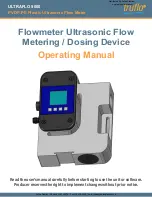
40
Operating Instructions
Basic Registers
Energy Registers
Commonly known as kWh (kilowatt-hours), the energy is the integral of power over time. Many
installations will only use the energy measurement. It is commonly used for billing or sub-meter-
ing. Because energy is an accumulated value, it can be used on networks that are accessed
infrequently (like a utility meter that only needs to be read once a month). All energy register
values are preserved through power failures.
In the WattNode Modbus meter, most energy registers can be reset to zero by writing “1” to the
ZeroEnergy
register. They can also be set to zero or a preset value by writing the desired value
directly to each register. All energy registers ending with “NR” (for non-resetting) cannot be reset
to zero for billing security. You can protect all energy registers from being zeroed or preset by
setting a
All energy registers wrap around to zero when they reach 100 gigawatt-hours (100 x 10
9
watt-
hours) or negative 100 gigawatt-hours (only some energy registers allow negative values).
During a power outage, the energy consumed will not be measured. Whenever the line voltage
drops below 60–80% of nominal, the meter will shut down until power is restored. To preserve
the energy measurement across power outages, the meter writes the energy to non-volatile (fer-
roelectric RAM) memory every second. When power returns, the last stored value is recovered.
EnergySum, EnergySumNR
EnergySum
is the net real energy sum of all active phases, where “net” means negative energy
will subtract from the total. This value is appropriate for net metering applications (i.e. photovol-
taic) where you wish to measure the net energy in situations where you may sometimes consume
energy and other times generate energy. Use
EnergyPosSum
instead if you don’t want negative
energy to subtract from the total.
EnergySum
is reset to zero when “1” is written to the
register.
The
EnergySumNR
is identical to
EnergySum
except that it cannot be reset to zero.
EnergyPosSum, EnergyPosSumNR
EnergyPosSum
is equivalent to a traditional utility meter that can only spin in one direction. Every
second, the measured real energies for each active phase are added together. If the result is
positive, it is added to
EnergyPosSum
. If it is negative, then
EnergyPosSum
is left unchanged.
EnergyPosSum
is reset to zero when “1” is written to the
register.
The
EnergySumPosNR
is identical to
EnergySumPos
except that it cannot be reset to zero.
Power Registers
PowerA, PowerB, PowerC
The WattNode meter measures real power (watts) for each phase (
PowerA, PowerB, PowerC
).
The measured power is generally positive, but may also be negative, either because you are
generating power (such as with solar panels), or because the meter isn’t connected properly.
The integer power registers are scaled by
to prevent overflow. The integer
power registers can only report values from -32767 to +32767. To allow for large power values,
PowerIntScale
acts as a multiplier to multiply by 1, 10, 100, or 1000. See
for details. To scale the integer
PowerA
,
PowerB
,
PowerC
, or
PowerSum
to
watts, use the following equation:
Power(W) = PowerSum • PowerIntScale
For example, if
PowerIntScale
(
1609
) is 100, and the integer
PowerSum
(
1209
) reports 2500,
then the power sum is 2500 * 100 = 250,000 W (or 250 kW).
















































